Piracy and Armed Robbery against Ships in the year 2011 From IMB Annual Report
Contents
On January 19, 2012, the International Maritime Bureau (IMB) of the International Chamber of Commerce (ICC) published a report through the Piracy Reporting Center (PRC) based in Kuala Lumpur on the incidents of piracy and armed robbery against the ships noted in the world in year 2011 (January 1−December 31, 2011). Below is a summary of the characteristics of the incidents of piracy and armed robbery against the ships viewed from the IMB report (hereinafter referred to as the Report) noted in the year 2011.
Regarding the definition of Piracy and Armed Robbery against Ships, the IMB accepts the “definition of piracy” in Article 101 of the United Nations Convention on the Law of the Sea (UNCLOS). As for the armed robbery, the IMB accepts the definition of the “Code of Practice for the Investigation of the Crimes of Piracy and Armed Robbery against Ships” which was adopted by the International Maritime Organization (IMO) in its Assembly session in November 2001.
(In view of circumstances for the descriptions, related Tables and Charts were carried en bloc at the end of the report.)
1. Characteristics viewed from numbers and locations of the incidents (including attempted attacks)
The number of the incidents reported in the year 2011 was 439 (445 in 2010). Of them, 221 (249 in 2010) were actual attacks. Of them, 45 (53 in 2010) were hijackings, and 176 (196 in 2010) incidents were boarding. There were 218 (196 in 2010)) attempted attacks. Of them, 113 (107 in 2010) cases were firing and 105 (89 in 2010) incidents were attempted boarding. However, the IMB is regarding there are a great number of the unreported cases apart from the reported cases, advising the shipping owners and masters of the ships to report all piratical attacks and suspicious movements of the crafts to the bureau.
The number of the incidents in 2011 decreased by six from 2010. As shown in the Table 1, the decrease was for the first time in the recent five years. Looking at 439 attacks in 2011 from the areas where the attacks were noted, 331 attacks, which equal nearly 75 percent of a total of attacks, have occurred in the seven areas as follows: 160 (139 in 2010) attacks off Somalia, 39 (25 in 2010) attacks in the Red Sea, 37 (53 in 2010) attacks in the Gulf of Aden, 46 (40 in 2010) attacks in Indonesia, 16 (18 in 2010) attacks in Malaysia, 13 (31 in 2010) attacks in the South China Sea, 20 (0 in 2010) attacks in Benin. Incidentally, top seven areas in 2010 included 19 (10 in 2010) attacks in Nigeria and 23 (10 in 2010) attacks in Bangladesh, and five areas above, with the exception of Malaysia and Benin.
As shown in Table 1, the number of attacks by Somali pirates marked 237 (219 in 2010) cases, which increased by 18 from 2010, occupying about 54 percent of the total higher than about 50 percent in 2010. Abnormality of attacks by Somali pirates continues to be conspicuous.
Furthermore, the attack area by Somali pirate continues to expand, and it covers, according to the Report, an entire area from a southern part of the Red Sea in the west to 72 degrees East longitude in the east, and, moreover, from off Oman and the Arabian Sea in the north to 22 degrees South latitude. These attack area was a vast marine waters including off Kenya, off Tanzania, off Seychelles, off Madagascar, off Mozambique, Arabian Sea, off Oman, off the Indian west coast, and off Maldives west coast (see Figure 1). As the Report is pointing out, using the hijacked merchant vessels, ocean going fishing vessels and dhow vessels as their “mother-ships,” Somali pirates are able to operate in such a vast area. The mother vessels launch skiffs to attack passing vessels.
As shown in Table 2, of 237 cases, the number of pirate attacks in the Gulf of Aden was 37 (53 in 2010). One was a case boarded, and four were cases hijacked, which is a significant reduction compared to 2010 (two were cases boarded and four were cases hijacked). In terms of the number of attempted attacks in the Gulf of Aden, 19 (22 in 2010) were cases fired upon and 13 (14 in 2010) were cases attempted boarding. In the case of in the Red Sea, four (none in 2010) were boarded and none (one in 2010) was hijacking. In terms of the number of attempted attacks in the Red Sea, 13 (four in 2010) were cases fired upon and 22 (20 in 2010) were cases attempted boarding. Regarding incidents off Somalia including the Indian Ocean, 15 (14 in 2010) were cases boarded and 23 (33 in 2010) were cases hijacked. In terms of the number of attempted attacks in the area, 78 (74 in 2010) were cases fired upon and 44 (18 in 2010) were cased attempted boarding. Adding one hijacked case in Oman, of 237 attacks by Somali pirates, 20 (16 in 2010) were cases boarded, 28 (49 in 2010) were cases hijacked, and 48 (65 in 2010) were actual attacks. The success rate of pirate attacks in 2011 was only 20 percent, which significantly declined compared to about 30 percent in 2010.
According to the Report, this decrease was the result of the deployment of naval vessels from the respective nations as well as ship’s application of self-protection measures by sheltering themselves in a security compartment called “citadel,” based on an anti-piracy manual for sailing vessels, the Best Management Practices version 4 (BMP4). On the subject of the operation of the naval vessels, the Report is pointing out that the success rate of hijacking has been significantly reduced due to these pre-emptive naval strikes that disrupted Pirate Action Groups (PAGs). In the last quarter of 2011, the navies have disrupted at least 20 PAGs. In 2011, 31 vessels were attacked of which only four successfully hijacked. As the Report estimates, the role of navies was critical to the anti-piracy efforts in this area (see Reference).
The Report cites Privately Contracted Armed Security Personnel (PCASP) as a factor in reducing the number of hijacking incidents. Regarding PCASP, for example, U.K. Prime Minister David Cameron announced on October 30 2011, that ships sailing under the British flag would be able to carry armed guards to protect them from pirate attacks. On December 7, the United Kingdom Department of Transport published rules regulating the carriage of armed guards on British merchant ships sailing off the coast of Somalia. In August, the Indian ministry of shipping issued guidelines allowing ships with Indian crew to deploy armed guards in a bid to combat piracy in the Gulf of Aden. Thailand announced that she would put four members of its armed guard units aboard each Thai merchant vessel to provide protection until it travels out of the piracy-prone sea lanes in the Gulf of Aden. The German government revealed that the government would carefully examine whether amendments to the legal framework are necessary in order to provide legal certainty for ship-owners that deploy armed guards. Italy plans to station military forces on national flag vessels to guard against attacks by Somali pirates. In January 2012, the Philippines gave a permission to deploy armed guards on board national flag vessels.
On October 18 2011, an executive of Protection Vessels International Ltd. (PVI, British private security company) revealed that vessels that PVI’s guards have come under attack 30 times in 3 1/2 years, but, the company said warning shots were enough to repel all the assaults without incurring any deaths or injuries (Bloomberg.com, October18, 2011). Regarding PCASP, it is expected that the deployment of armed guards or military forces on board national flag vessels would increase, and there would be legal issues such as amendments to the legal framework of interested states and gun regulations in case of sailing in other territorial waters and areas outside of pirate-infested waters.
As Table 1 and 2 shows, in Southeast Asia, the number of incidents in Indonesia was 46. The number of? pirate attacks has continued to rise in the recent two years. In Indonesia, the incidents have most frequently occurred in the South China Sea in the vicinity off Anambas, Natuna, Mangaki, Subi Besar, and Merudung area. Three tug & barges at sea have been hijacked. The South China Sea had 13 attacks against sailing vessels, which substantially dropped from 31 attacks in 2010. One tug & barges at sea has been hijacked. In the South China Sea, the incidents have most frequently occurred in the seas around the Indonesian islands noted above. The Strait of Malacca had one attack, which has continued to reduce since 2008. The Singapore Strait had 11 attacks, which significantly increased from 3 attacks in 2010.
On the other hand, as shown in Table 2, the Sea area in the Gulf of Guinea on the west coast of Africa is the hot spot of violent pirate and armed robbery incidents. In particular pirate attacks off Benin are most noticeable in 2011. According to the Report, 20 attacks were against tankers, eight of which were hijacked. The periods of time in captivity in the water in the Gulf of Guinea tend to about ten days as compared to the average of six months for Somali hijackings. According to the Report, pirate attacks in the water in the Gulf of Guinea are however considerably more violent.
2. Characteristic viewed from activities
The Table 3 shows the status of ships attacked, including the attempted cases, by location in 2011. According to the Table 3, regarding the status of the vessels when they were attacked, of 221 actual attacks (a/a) in 2011 (249 a/a in 2010), 5 attacks (15 a/a in 2010) were noted while the vessels were berthed in port, 120 attacks (115 a/a in 2010) were noted while the vessels were anchored, and 96 attacks (119 a/a in 2010) were noted while the vessels were steaming. Additionally, of 218 attempted attacks in 2011 (196 cases in 2010), two cases (three cases in 2010) were noted while they were berthed, 12 cases (16 cases in 2010) were noted while they were anchored, and 204 cases (177 cases in 2010) were noted while the ships were steaming.
According to the Table 3, all attacks by Somali pirates were made while the vessels were steaming, and all attempted attacks are “fired upon” and/or “boarding” cases (see Table 2), which indicate the features of Somali pirates that are armed with their automatic weapons and rocket-propelled grenades (RPG) and attack the steaming vessels with their “mother-ships” and skiffs. On the other hand, the features of pirate attacks in Asia are that the attacks were mostly the boarding cases while the vessels were steaming. Additionally, in Vietnam, Bangladesh and India all attacks were boarding cases in ports and anchorages.
Also, in 17 locations (16 locations in 2010), more than three attacks were reported respectively while the ships were berthed or anchored in 2011. The highest number of attacks was 19 cases (none listed in 2010) in Cotonou in Benin. In Indonesia, there were 13 cases (three cases in 2010) in Dumai in Sumatra, which was a big increase. Also, there were six cases (four in 2010) in Jakarta/Tanjung Priok, five cases (none listed in 2010) in Belawan in Sumatra, four cases (none listed in 2010) in Samarinda in Kalimantan, and three cases (none listed in 2010) in Surabaya in Java. At anchorages in the Singapore Straits, there were 11 cases, which was a dramatic increased as compared to three cases in 2003. There were three cases (three cases in 2010) in Manila in the Philippines, and three cases (seven cases in 2010) in Vung Tau in Vietnam. There were 10 cases Chittagong in Bangladesh, which decreased by more than half as compared to 22 cases in 2010. There were four cases (none listed in 2010) in Cochinin India.
3. Characteristics of vessels attacked
What types of vessels were attacked as the targets of the pirates/robbers? As shown in the Table 4, the number of types of ships attacked (including those involved in attempted attacks) is totaled 25 (30 in 2010), and the number of ships by type involved in attacks (cases) (including attempted attacks) in 2010 was noted as follows: First is the highest number of 100 attacks (96 and 89 in 2010) for the chemical /product tankers and bulk carriers, and the second are 62 cases (74 in 2010) for containers. Following are 61 cases (43 in 2010) for crude oil tankers, 35 cases (63 in 2010) for general cargo vessels, 32 cases (20 in 2010) for tugs, 11 cases (19 in 2010) for fishing trawlers. In the past five years seven types of these vessels occupied a greater part of the vessels targeted, even though there were, more or less, up and down in the numbers of the vessels attacked by pirates.
Looking at the vessels attacked by registration, of 439 ships, the highest number of 71 (82 in 2010) was given to Panamanian-registered vessels. The following were, according to the ranking by registration, in which more than 10 vessels were attacked, 57 (57 in 2010) Liberian-registered vessels, 45 (36 in 2010) Marshall Islands-registered vessels, 32 (40 in 2010) Singaporean-registered vessels, 25 (19 in 2010) Malta-registered vessels, 21 (18 in 2010) Hong Kong (SAR)-registered vessels, 16 (24 in 2010) Antigua Barbuda-registered vessels, 14 (14 in 2010) Malaysia-registered vessels, 12 (3 in 2010) Greek-registered vessels, and 11 (10 in 2010) Bahamas-registered vessels. One Japanese-registered vessel was attacked in 2011. (Throughout the past five years, two attacks in 2008, and one attack in 2007 were noted.)
On the other hand, looking at the operational status of the vessels attacked by Flag State (Countries where victim ships are controlled / managed), the highest number of 65 (54 in 2010) were given to Singaporean vessels, Following are 64 (69 in 2010) German vessels. 58 (46 in 2010) Greek vessels, 27 (16 in 2010) Hong Kong vessels, 19 (23 in 2010) Japanese vessels, 17 (14 in 2010) Malaysian vessels, 14 (14 in 2010) Indian vessels, 12 (17 in 2010) UAE vessels, 12 (16 in 2010) British vessels, 12 (9 in 2010) Chinese vessels, 12 (nine in 2010) Denmark vessels, 10 (10 in 2010) Netherlands vessels, 10 (10 in 2010) Norwegian vessels, and others.
4. Types of violence to crews and peculiarities of weapons used
Looking at the status violence (or damage) to crews, as the Table 5 shows, the incidents in which crews were taken hostage dramatically decreased. In 2011, 802 persons (1,181 persons in 2010) were taken hostage. In view of the trends in the past five years, compared with 188 persons in 2006 and 292 persons in 2007, there were 889 persons in 2008, which almost tripled. Since then, looking at 1,052 persons in 2009 and 1,181 persons in 2010, the number has been increasing by more than 100 every year. The number in 2011, however, decreased by more than 300 as compared to a year earlier.
On the other hand, looking at the violence by locations, of 802 hostage incidents in 2011 (1,181 hostage incidents in 2010), 47 cases (275 cases in 2010) in the Gulf of Aden and 402 cases (732 cases in 2010) in Somalia, all by Somali pirates, were noted, occupying about 56 percent of the hostage incidents as compared to less than 90 percent in 2010. Of eight incidents in which persons were killed by Somali pirates (eight cases in 2010). The reduction in the number of hostage incidents by Somali pirates was due to that fact that the number of hijacking incidents decreased from 49 cases in 2010 to 28 cases in 2011. Regarding kidnapping incidents by Somali pirates, hostages are held at pirate’s bases on land, not inside hijacked vessels.
According to the Report, as of December 31 2011, suspected Somali pirates held 11 vessels for ransom with 193 crew members as hostages. Regarding hostage incidents by Somali pirates in 2011, it is worth noting that there were some cases in which the pirates continued holding certain country hostages to swap them for pirates held in custody in the hostages’ home country even after releasing vessels that the crews had been on board. For example, according to the Somali Report dated October 28 2011, Somali pirates are now hunting specifically for Indian seafarers in an effort to pressure the Indian government to release Somali pirates being held in Indian jails. The pirates are searching for Indians among the nearly 300 sailors already being held hostage on various hijacked ships and on land. The pirates declared that they would not release any Indian crews until the Indian government releases their peers in their jails. According to the release, as of October 2011, India held 105 Somali pirate suspects. On the other hand, Somali pirates were holding at least 53 Indian hostages including 46 on hijacked vessels and seven others on land. On November 30 2011, Somali pirates released the Singapore-flagged product tanker MT Gemini operated by a Singaporean company. Of her 25 crewmembers, 21 men were released, but pirates still keep Korean captain and three crewmembers. Pirates are holding South Korean sailors as a compensation for five [pirate suspects] held in custody in South Korea while the Korean Navy stormed and released the hijacked South Korean tanker Samho Jewelry on January 21, 2011. (Maritime Bulletin, December 2, 2011)
On the other hand, Somali pirates make business sense to release hijacked vessels and crewmembers as hostages in return for a heavy ransom. According to the Somalia Report, Weekly Report, on December 30 2011, estimated ransom payments in 2011 amount to $154.0 million for the release of 34 vessels (see Figure 2). Additionally, as of the end of December, at least 15 ships (eight commercial vessels, seven fishing vessels) and an estimated 268 crewmembers are in the control of Somali pirates, or held hostage by them.
The Table 6 shows types of arms used by pirates in all incidents in 2011 by location. There are few changes in the trends that guns and knives are major arms of pirates for the past five years. On the other hand, looking at the types of arms to be used by pirates by location, of a total of 245 attacks (243 cases in 2010) in which guns were used, 33 cases (48 cases in 2010) in the Gulf of Aden, 32 cases (13 cases in 2010) in the Red Sea, 135 cases (130 cases in 2010) in Somalia, which occupied nearly 82 percent of the accidents, were noted. This will make us find how dangerous the Somali pirates armed with AK-47 rifles and RPG-7 rocket weapons are. The number in Benin and Nigeria was 29 cases (16 in 2010), which shows violent characteristics of pirate attacks frequently using guns in the waters in the Gulf of Guinea.
Table 1: Trends of incidents (including the attempted attacks) that occurred frequently in Asia and other areas in the recent five respective years
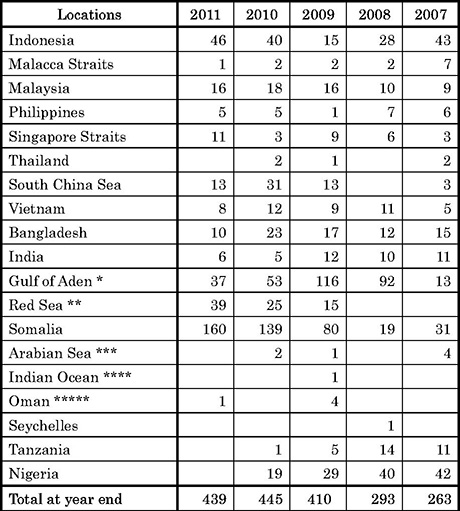
Source: Made from Table 1 in the IMB Piracy and Armed Robbery against Ship, Annual Report (January 1 − December 31, 2011), pp. 5-6. The total of the incidents covers all area in the report.
Note: *: Gulf of Aden; **: Red Sea; ***: Arabian Sea; ****: Indian Ocean; *****; Oman. All of the above attacks are attributed to Somali pirates.
Table 2: Status of attacks frequently noted in Asia and other areas in 2011
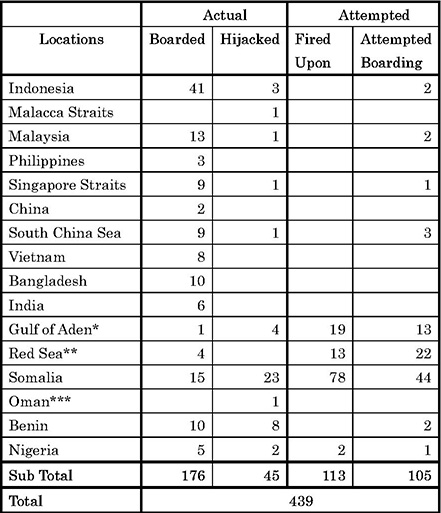
Source: Made from Table 2 in the IMB Piracy and Armed Robbery against Ship, Annual Report (January 1 − December 31, 2011), p. 8. The total of the incidents covers all areas targeted in the report.
Note: *: Gulf of Aden; **: Red Sea; ***: Oman. All areas are attributed to Somali pirates.
Remarks: “Boarded” covers an incident, in which pirates gave up hijacking and fled the ship they have successfully boarded. In this case, most of crew-members took self-protection measures by sheltering themselves in a security compartment called “citadel,” locking it from inside. Afterwards, the ship was eventually rescued by the foreign naval vessel patrolling in the vicinity. On the other hand, if pirates did not flee from the ship, the situation sometimes led to a case of rescuing the crew-members by military force.
Table 3: Status of ships attacked (including the attempted cases) by location in 2011
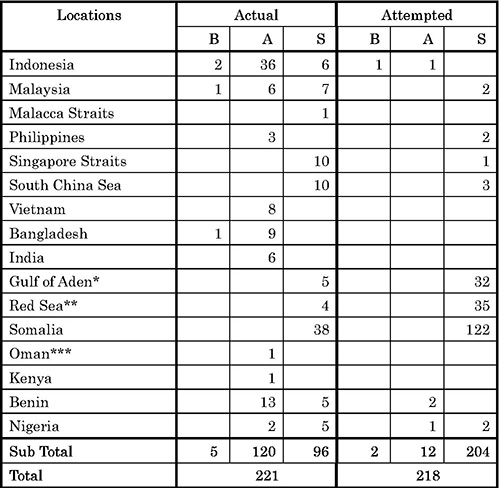
Source: Made from Table 4 and Table 5 in the IMB Piracy and Armed Robbery against Ship, Annual Report (January 1 − December 31, 2011), pp. 9-10. The total of the incidents covers all areas targeted in the report.
Remarks: B = Berthed, A = Anchored, S = Steaming.
Note: *: Gulf of Aden; **: Red Sea; ***:Oman. All areas are attributed to Somali pirates.
Table 4: Types of vessels attacked (3 or more) and trends in the past 5 years
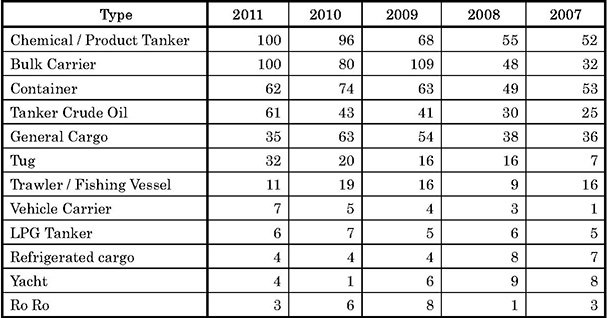
Source: Made from Table 11 and Chart D in the IMB Piracy and Armed Robbery against Ship, Annual Report (January 1 − December 31, 2011), p. 13-14.
Table 5: Types of violence noted frequently in Asia and other areas in 2011
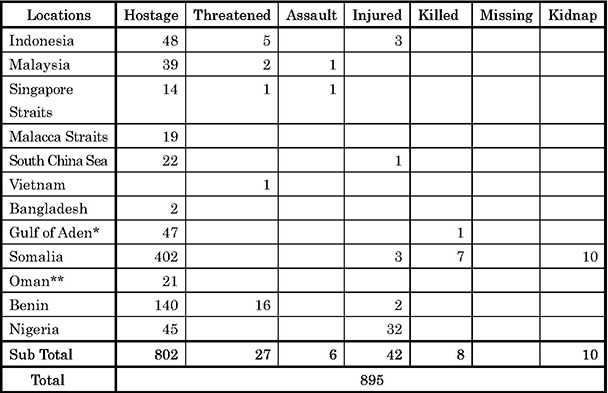
Source: Made from Table 9 in the IMB Piracy and Armed Robbery against Ship, Annual Report (January 1 − December 31, 2011), pp. 11-12. The total of the incidents covers all areas targeted in the report.
Note: *: Gulf of Aden; **: Oman. All areas are attributed to Somali pirates.
Figure 2: 2011 ransoms as of December 30
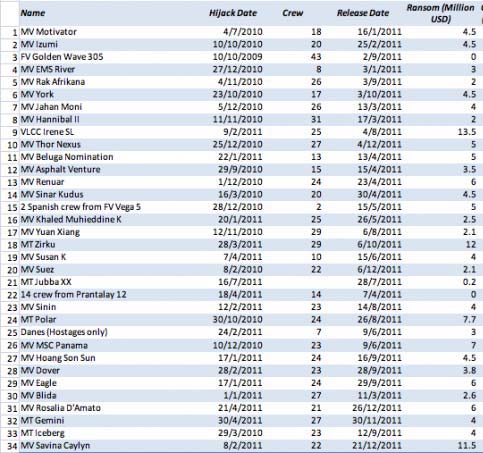
Source; Somalia Report, December 30, 2011
Table 6: Types of arms used frequently by pirates in Asia and other areas
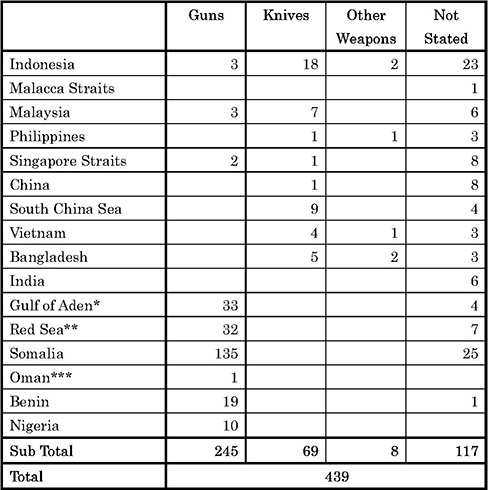
Source: Made from Table 10 in the IMB Piracy and Armed Robbery against Ship, Annual Report (January 1 − December 31, 2011), p. 12-13. The total of the incidents covers all areas targeted in the report.
Note: *: Gulf of Aden; **: Red Sea; ***: Oman. All areas are attributed to Somali pirates.
From “Intelligence Analysis (January 2012)”
関連記事
